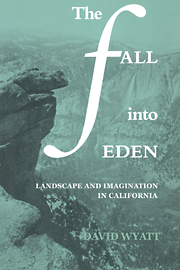Book contents
- Frontmatter
- Contents
- List of illustrations
- Acknowledgments
- Prologue: The mythology of the region
- 1 Spectatorship and abandonment: Dana, Leonard, and Frémont
- 2 Muir and the possession of landscape
- 3 King and catastrophe
- 4 Mary Austin: nature and nurturance
- 5 Norris and the vertical
- 6 Steinbeck's lost gardens
- 7 Chandler, marriage, and “the Great Wrong Place”
- 8 Jeffers, Snyder, and the ended world
- Epilogue: Fictions of space
- Notes
- Bibliography
- Index
3 - King and catastrophe
Published online by Cambridge University Press: 18 December 2009
- Frontmatter
- Contents
- List of illustrations
- Acknowledgments
- Prologue: The mythology of the region
- 1 Spectatorship and abandonment: Dana, Leonard, and Frémont
- 2 Muir and the possession of landscape
- 3 King and catastrophe
- 4 Mary Austin: nature and nurturance
- 5 Norris and the vertical
- 6 Steinbeck's lost gardens
- 7 Chandler, marriage, and “the Great Wrong Place”
- 8 Jeffers, Snyder, and the ended world
- Epilogue: Fictions of space
- Notes
- Bibliography
- Index
Summary
eminence and fall
Lunching on the abyss was Clarence King's (1842–1901) idea of a good time. King and his fellow surveyor have been toiling over the ice fields on Shasta's flanks. Lost among “impassable gulfs,” King decides to break for lunch:
a lately quieted stomach is the best defence for nerves. So when we got into a pleasant, open spot where the glacier became for a little way smooth and level, we sat down, leisurely enjoying our repast. We saw a possible way out of our difficulty, and sat some time chatting pleasantly. When there was no more lunch we started again, and only three steps away came upon a narrow crack edged by sharp ice-jaws. There was something noticeable in the hollow, bottomless darkness seen through it which arrested us, and when we had jumped across to the other side, both knelt and looked into its depths. We saw a large domed grotto walled in with shattered ice and arched over by a roof of frozen snow so thin that the light came through quite easily. The middle of this dome overhung a terrible abyss. A block of ice thrown in fell from ledge to ledge, echoing back its stroke fainter and fainter. We had unconsciously sat for twenty minutes lunching and laughing on the thin roof, with only a few inches of frozen snow to hold us up over that still, deep grave.
Courtship of disaster recurs in King's story as a curiously obsessive pattern. What will to risk himself was it that he tested by chasing an aroused grizzly, headfirst, into a smoky cave? (He sailed out safely with the bear shot through the brain.)
- Type
- Chapter
- Information
- The Fall into EdenLandscape and Imagination in California, pp. 47 - 66Publisher: Cambridge University PressPrint publication year: 1986

